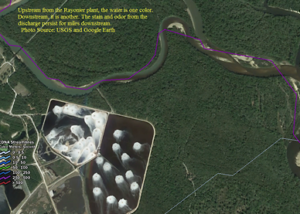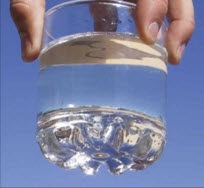Altamaha Riverkeeper News
Push EPA to Urge Rayonier AM to Clean Up its Discharge
By Mark Yeager
For the second time in four years, Georgia’s largest river – the Altamaha –rates among “Georgia’s Dirty Dozen,” published by the Georgia River Network, a coalition of thousands of concerned Georgia voters. The Altamaha River is “dirty” because of massive industrial wastewater pumped into it by a pulp mill.
The aging saga of pollution downstream from Rayonier Advanced Materials (RYAM) pulp mill near Jesup, Georgia, began three generations ago in 1954 when grandfather company Rayonier moved from Washington to Georgia. The manufacturing process requires more water daily than a medium-sized city uses. RYAM draws 60 million gallons of pristine water out of the Floridan aquifer that Georgians depend on for drinking water, loads it with chemical and industrial byproducts required to manufacture cigarette filters and disposable diapers, then pumps 60 million gallons of waste byproducts into the river. High velocity pumps produce the equivalent volume of the ten-week-long BP oil spill every 3.5 days, gushing from submerged pipes along the riverbed.
And this process has continued every working day for decades.
Georgia receives payroll taxes and sales tax revenue in exchange for saying this is a good use of our resources. The depletion of our drinking water supply, the chemical stench, the inedible fish and the miles and miles of discolored water: that is the bargain we have made so Georgia can be the world’s leading producer of cigarette filters. Wastewater treatment methods have come a long way since RYAM earned newspaper write-ups for massive fish kills. But RYAM has nourished a culture of foot-dragging, stubbornly resisting good stewardship entrusted to it by the state and its citizens.
A full twenty miles of the Altamaha River is visually impacted. A through-kayaker recently en route to the delta town of Darien described his experience, and posed a fundamental question for all Georgians:
“Below the plant, the water took on a more reddish color and the smell made me nauseous as I paddled only inches above it. As I paddled along all I could think about was, what gives anyone the right to destroy the river for everyone and everything else?
The answer: A legal document called National Pollutant Discharge Elimination System (NPDES) permit that is currently under review for 2016 renewal by Georgia Environmental Protection Division (EPD).
The effect of the NPDES permit is to shield RYAM from costs associated with any meaningful modernization of its wastewater treatment. How? Because EPD does not include the state’s own water quality standards in wastewater permits.
RYAM boasts having spent millions on upgrades, but mostly on replacing worn out equipment, rather than for any effective process. Modern processes utilized in the developing world yield clear effluent, shown in the photo below from a Chilean mill. We have a federal Clean Water Act (CWA), but what we haven’t had is clean water.
Why can’t EPD permits include standards similar to those acceptable in developing countries? Why not include the state’s own water quality standards?
Good stewardship of state waters exists at Weyerhauser’s pulp mill on the Flint River near Oglethorpe, Georgia. Weyerhauser voluntarily implemented “an aggressive and efficient oxygen delignification system to remove lignins from the pulp and burn them, instead of removing them with chlorine dioxide and dumping them to the river as at Jesup,” explains industry expert Neil McCubbin. He adds, “Rayonier insists that oxygen delignification cannot work with their pulp/products, but foreign competitors have disproven this.”
RYAM’s corporate suite in Jacksonville has an opportunity to abandon its plodding, Industrial Revolution-era “take, make, waste” way of thinking. But given its history, the outcome is uncertain.
Reluctant industries need nudging. The tools of change in a democratic society come in several forms:
- Administrative regulation – EPD has been decidedly favorable to RYAM so far;
- Judicial – In the recent brief legal contest between Altamaha Riverkeeper and RYAM, the federal judge sided with RYAM, but suggested that RYAM may have violated environmental laws, and highlighted weakness in contract language in the current NPDES permit, and;
- Legislative – Pressure on Georgia legislators by many concerned voters would be needed to add the CWA narrative to all EPD permit agreements. Currently, it is not included in EPD-issued permits.
The most effective form of change comes from within industry itself, and is usually initiated at the very top.
RYAM’s CEO Paul Boynton might take a cue from “Business Lessons From a Radical Industrialist,” a book by the late Ray Anderson, the founder of Interface Carpet Tile in LaGrange, Georgia. Anderson’s risky 1994 midcourse correction – pointing his entire company toward a sustainable path – eventually changed the entire carpet industry in Georgia. Anderson and company’s dedication to the principle and practice of sustainability proved to be profitable, and was motivated by doing the right thing for future generations.
Prior to Anderson’s personal epiphany, the carpet industry and RYAM’s pulp mills had these things in common: they were both dirty, polluting, and “in compliance.” Interface is now light years ahead of RYAM – without any prodding from regulatory agencies – and doing quite well financially, and as a corporate culture.
The NPDES permit renewal is imminent, and RYAM may not be able to put itself on a sustainable path overnight Therefore, EPD should act now and limit wastewater color discharge, achieving several positive things: 1) Groundwater demand would be cut in half, and; 2) Wastewater volume would be reduced, eliminating most of its nauseating odor, and aquatic life would be restored to healthy levels in the river. Other internal adjustments by RYAM would be necessary:
- First, RYAM should recognize there is a problem in the river. Under the current EPD permit limits, clean wastewater is not expected for two more generations.
- Second, RYAM should also reconsider its misleading website statement that “there is currently no technologically feasible way to remove all color from the water.” No one is asking RYAM to remove “all color” because perfection is unattainable. Moreover, proven technology is feasible and available.
- And third, RYAM and all its employees should relax and recognize that no pulp mill in the world is known to have closed its doors because it upgraded its wastewater treatment process.
If GA EPD does not include the state’s own water quality standards in the permit, then US EPA should intervene, enforce the Clean Water Act, and put the permit renewal on hold until discussions among stakeholders are concluded with agreement on the above limits.
If you have comments on setting new wastewater byproduct and color limits, and restoring health to the Altamaha River, please email them to: Jim Giattina, EPA Water Division Director, giattina.jim@epa.gov
There are so many ways that you can help keep our rivers clean and beautiful. Responding to Action Alerts or reaching out to your elected representatives. Find your way to get involved!



